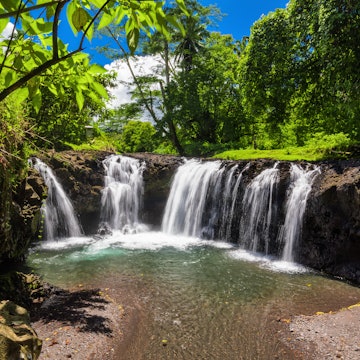
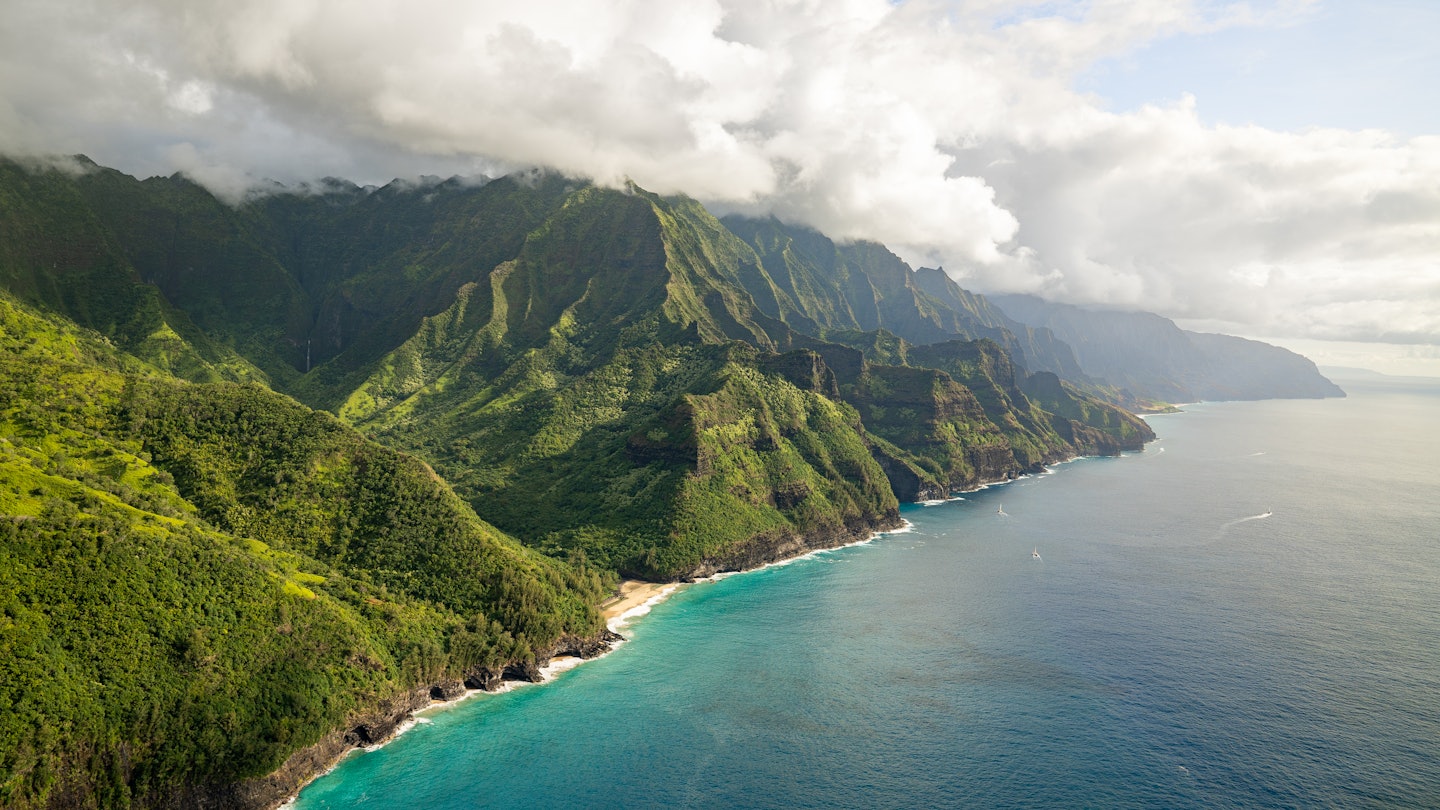
Kauaʻi’s stunning Nāpali Coast. Nathan Stanina/Shutterstock
Hawaiʻi may have a reputation for being a relaxed, laid-back destination. And that‘s true – to an extent. The Islands have their own quirks, customs and unspoken rules that even the most well-intentioned visitor can overlook or ignore. Even something as simple as tossing out an old lei – flower garland – can be deemed as disrespectful.
Here are some dos and don’ts to keep in mind when visiting the 50th state.
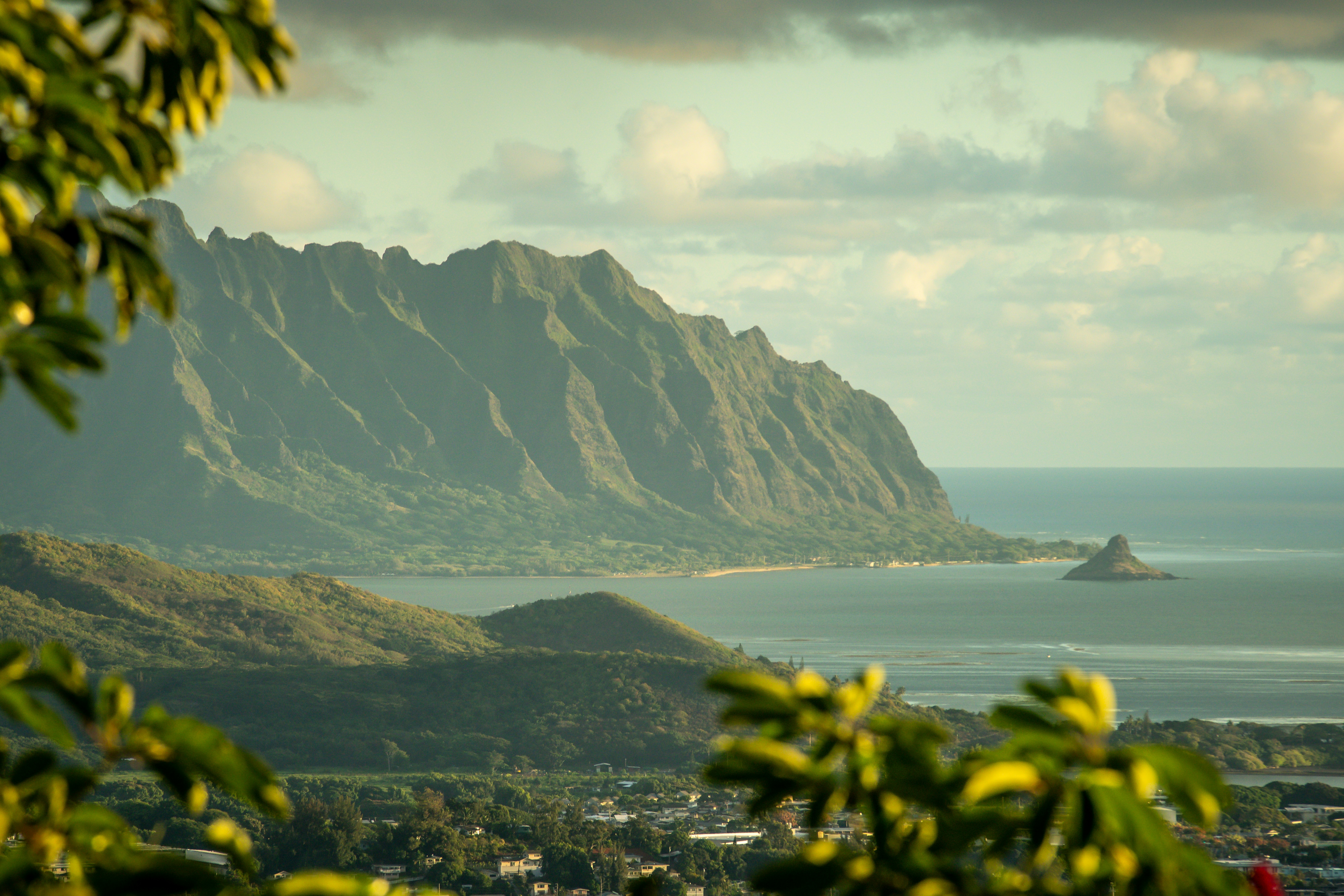
When planning your vacation
1. Don’t just plan a trip to Oʻahu – or a single island. If you’re making the trek all the way to Hawaiʻi, consider visiting another island, even just for the day. While Oʻahu generally gets the bulk of visitors, the other islands offer unique experiences you won’t want to miss. Flights are frequent between islands and don’t take longer than 45 minutes.
2. Do rent a car. While some visitor hubs – like Waikīkī on Oʻahu and Kona on Hawaiʻi Island – are walkable, you won’t be able to experience the full scope of any island without driving around it. Only Oʻahu has extensive public transportation, from a city-run bus system that can get you anywhere on the island to a bike ride-share program in a few urban areas. Most islands have Uber and other ride-share options, but fares can get expensive. By car, you can explore rural neighborhoods, find secluded beaches and see more of the island’s natural beauty.
3. Don’t expect perfect weather all day, every day. While Hawaiʻi is known for its idyllic climate and year-round sunshine, it does – and will – rain, especially in the winter and spring months. Some of Hawaiʻi’s peaks, like Kauaʻi’s Mount Waiʻaleʻale, are among the wettest spots in the world. And depending on when and where you’re planning to visit, it can be cold, too. Weather in higher-elevation areas can be chilly and unpredictable. The temperature at the summit of the 10,023-ft Haleakalā on Maui, for example, is about 30°F cooler than the coast and can dip below freezing. Snow at the summits of Halekalā and Mauna Kea on Hawaiʻi Island is a common occurrence during the winter months. Pack a sweater or rain jacket, just in case.
4. Do book reservations for popular visitor attractions, tours and shows in advance. During the pandemic, the state began implementing reservation systems at many of its popular parks, including Hanauma Bay and Diamond Head State Monument on Oʻahu, Hāʻena State Park on Kauaʻi and Waiʻānapanapa State Park on Maui. These parks require entry fees, too, for non-residents. You even have to book a time slot up to 60 days in advance to see the sunrise at Halekalā on Maui. Many popular restaurants and shows fill up, too, so best to book ahead.
5. Lahaina is still recovering, but do consider West Maui. Lahaina continues to heal from the deadly wildfires that devastated the coastal town in 2023. And although visitors aren’t allowed into the core of Lahaina, the rest of West Maui is open – and needs support. Consider visiting towns like Kāʻanapali and Kapalua, which boast golden-sand beaches, sprawling resorts and great shops and restaurants. Some beloved Lahaina businesses have reopened, including Sale Pepe Pizzeria e Cucina, Old Lahaina Lūʻau and Māla Ocean Tavern.
Social etiquette and interactions
6. Do learn a few Hawaiian words, but don’t try to speak the language if you’re not fluent in it. You’ll hear words like “aloha” (hello), “mahalo” (thank you) and “pau” (finished), so it’s a good idea to familiarize yourself with commonly used phrases. The Hawaiʻi Tourism Authority has a great list of words and phrases to know before your trip to the Islands. But don’t try to speak ʻŌlelo Hawaiʻi to everyone you meet; only about 2% of the state’s population have some fluency in the language. It might come off as disrespectful. Apps like Duolingo now offer free beginner lessons in the Hawaiian language, making it easy to get started before or during your trip.
7. Don’t assume everyone who lives in Hawaiʻi is Hawaiian. Sure, someone from California is often called a Californian, but it’s not the same in Hawaiʻi. Hawaiian is an ethnicity also known as kanaka maoli. Someone born and raised in Hawaiʻi might be Japanese, Portuguese, Filipino or Caucasian, but they are not Hawaiian unless they’re of Hawaiian descent. Residents are referred to as kamaʻāina.
8. Do take off your shoes when you’re going inside someone’s home. It’s considered bad manners to keep them on indoors. Plus, practically speaking, walking indoors without shoes ensures cleaner floors and carpets.
9. Do accept any lei that’s presented to you, but don’t toss it in the trash. Lei is considered sacred and there’s a lot of cultural significance to them. When you receive a lei – and you likely will when you check into any hotel in Hawaiʻi – you should lower your head and allow the giver to put it over your head and onto your shoulders. (Don’t take it from the giver; that’s considered rude.) And instead of dumping the lei, place it nicely on a table in your room.
10. Don’t stack rocks. It’s not a traditional practice, and it’s considered culturally insensitive to do it. Native Hawaiians used rocks to build ahu (altars) for ceremonial purposes and as markers – not for decorative purposes. The Hawaiʻi Division of State Parks also discourages visitors from stacking rocks, as it modifies the natural setting and poses a safety hazard. And the Hawaiʻi Volcanoes National Park urges visitors not to move rocks; its staff builds ahu to mark trails and moving them or stacking others can create confusion for hikers and park-goers. Leave rocks, plants and other natural objects as you find them.

When getting around
11. Don’t honk. It’s not something Hawaiʻi drivers do.
12. Do drive with patience and within speed limits. Hawaiʻi has relatively low speed limits, with highways maxing out at 60 mph. You can be fined at least $100 for speeding, with additional fines depending on how fast you were driving.
13. Do pull over for other drivers on narrow roads and one-lane bridges. (You’ll find these in places like Hāna on Maui and Hanalei on Kauaʻi.)
14. Do wave or flash a shaka when another driver lets you merge or cut in.
15. Do heed Hawaiʻi’s biking rules. Oʻahu is probably the most bike-friendly of all the islands, with nearly 60 miles of bike lanes and 46 miles of bike paths. But note the rules. You can’t ride bicycles on the sidewalks in business districts like Waikīkī and Downtown Honolulu. And you can get stopped for biking while intoxicated; in Hawaiʻi bicycles are defined as vehicles and the state’s DUI statute applies.
When you're outdoors
16. Do use reef-safe sunscreen. In 2021 Hawaiʻi banned sunscreens that contain oxybenzone and octinoxate, chemicals that have been shown to damage fragile marine ecosystems. You can find reef-safe alternatives everywhere, from convenience stores to hotel shops. There are a few locally made options, too, such as Little Hands Hawaiʻi and Raw Love.
17. Don’t leave valuables unattended in your car or on the beach. Best to leave them at the hotel and take only your essentials – wallet, phone, keys – with you.
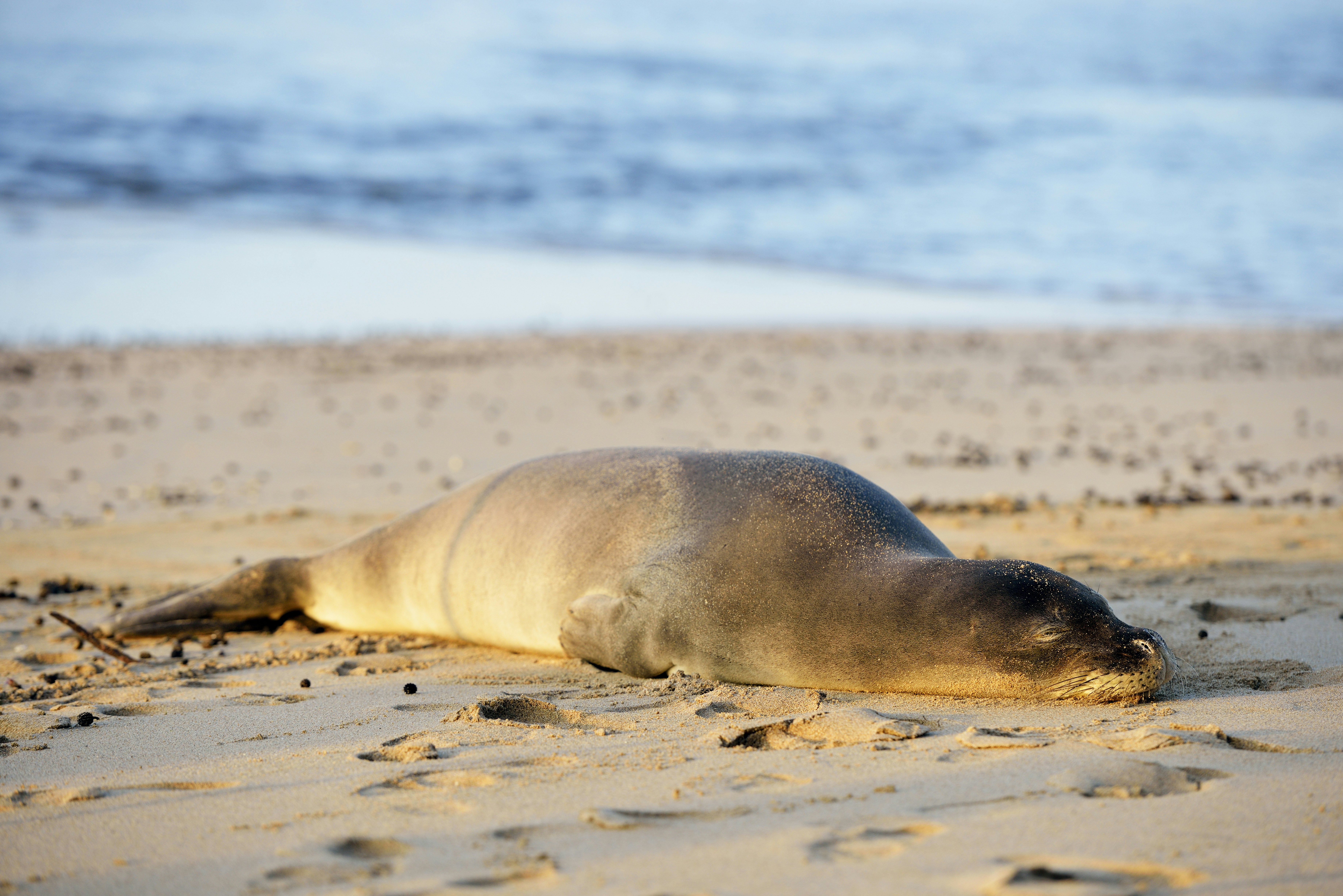
18. Don’t get too close to Hawaiʻi’s protected wildlife. Sure, it’s exciting to see a honu (Hawaiian green sea turtle) or nēnē (Hawaiian goose) in the wild. But these animals are protected by law, requiring you to keep your distance. It’s a felony under state law to touch, harass, harm or kill any endangered or threatened species, including Hawaiian monk seals, with penalties of up to five years in prison and a $50,000 fine. You have to be at least 10ft (3m) away from sea turtles on land and in the water; behind signs or barriers or at least 50ft (15m) away from Hawaiian monk seals; at least 50yds (45m) from dolphins; and it’s against federal law to be within 100yds of a humpback whale. Enjoy them from a safe distance.
19. Don’t stand on a rock ledge near the ocean. It may seem like the perfect spot to snap a photo – until a wave knocks you down and drags you out to sea. The ocean can be unpredictable, and rocks can be very slippery and dangerous when wet.
20. Don’t stand too close to a blowhole. While it may be exciting to see water shoot a hundred feet in the air, blowholes like Nākālele on Maui and Hālona on Oʻahu are best viewed from a safe distance. The force of the water can knock you down or wash you into the ocean.
21. Don’t stand on the reef. Not only are you damaging this important marine ecosystem, you might also step on a spiny sea urchin. Not fun!
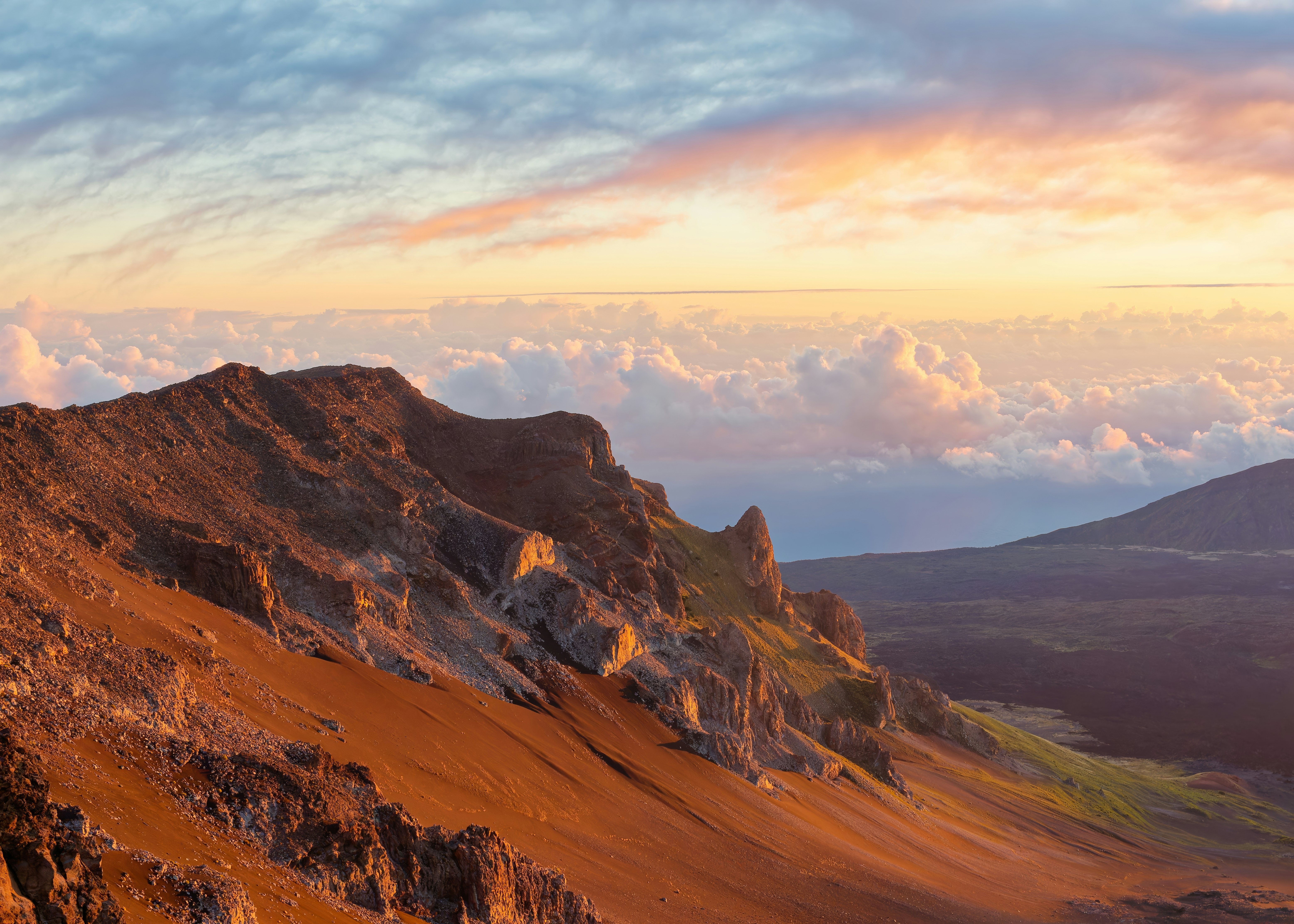
22. Do leave lava rocks alone. For decades, people have taken lava rocks from Hawaiʻi Volcanoes National Park and Haleakalā National Park as souvenirs. And many send them back, worried about the myth that says anyone who takes rocks from Hawaiʻi will be cursed. While that may not be true, there’s an even simpler reason: It’s illegal – not to mention culturally inappropriate – to take anything from a national park, including lava rocks. Taking rocks can alter the geological story, negatively impact native biodiversity and tamper cultural and archeological sites.
23. Don’t cross protective barriers or ignore warning signs. This seems like a no-brainer, but you’d be surprised how many people – visitors and locals alike – ignore warnings and venture into dangerous areas. For example, every month box jellyfish invade south shorelines on Oʻahu, and lifeguards post signs. Still, people wade into the ocean only to get stung by one of these venomous marine invertebrates.
24. Don’t swim in brown or murky water. This usually occurs after heavy rains or near river mouths. Brown water typically means high levels of bacteria and swimming in it, especially with an open cut, could result in a bad infection.
25. Do check in with lifeguards. Most of the popular beaches in Hawaiʻi are staffed with trained lifeguards, with Oʻahu boasting the most. Stop by the towers to ask lifeguards about current weather and ocean conditions, possible dangers and posted warnings. When in doubt, don’t go out.

When hiking
26. Do hike only on state-run trails or those in national parks. The state’s trail system encompasses 855 miles of trails and access roads across all major islands, from the paved walk to the Makapuʻu Lighthouse on Oʻahu to the epic 22-mile Kalalau Trail on Kauaʻi’s Nāpali Coast. Stay on the marked trails and never venture on closed hikes – like Haʻikū Stairs (Stairway to Heaven) on Oʻahu – or across private property. You could face steep fines and even jail time.
27. Do pack the essentials. You’ll need water – a good rule of thumb is to carry at least 1L of water per person for every two hours of hiking – and snacks like protein bars, fruit or trail mix. Wear sturdy but comfortable hiking shoes, slather on sunscreen and insect repellent, and bring a rain jacket just in case.
28. Don’t hike alone and do tell someone where you will be hiking and what time you expect to return.
29. Do bring a charged cell phone, in case of emergency. If you want, pack a solar charger.
30. Do hike within your physical limits. Don’t push yourself. Hiking is strenuous, and weather conditions can make the trek more challenging than you anticipated. It’s OK to turn around.
Dining and food customs
31. Don’t just eat at chain restaurants. While we all love the familiarity of our favorite eatery, you’d be missing out on experiencing the best part of traveling somewhere new: the food! Find hole-in-the-wall restaurants, ask locals or consult food blogs to find great local restaurants, cafés and bars.
32. Do eat outside your comfort zone. Thanks to the multiethnic diversity in the Islands, Hawaiʻi boasts an eclectic array of cuisines, from Vietnamese street food to farm-to-table fine dining. Try a cuisine you’ve never had before. And definitely experience Hawaiian food – like kālua pig, lau lau, poi and haupia – whether at a restaurant like Helena’s Hawaiian Food on Oʻahu or at a traditional lūʻau like Old Lahaina Lūʻau on Maui.
33. Do try Spam – or at least a Spam musubi. Hawaiʻi consumes an estimated 7 million cans of Spam annually, making it the state with the highest per capita consumption of the canned meat in the US. You’ll find Spam everywhere. Its most popular form, though, is Spam musubi: a grilled slice of Spam fixed on a bed of rice and held together with seaweed, or nori. You can find Spam musubi at convenience stores, gas stations and grocery stores. Some restaurants even serve elevated versions.
34. Don’t forget to tip. And that goes beyond restaurant servers. Show some love to tour guides, valet, bellhops, housekeepers and taxi or ride-share drivers.

35. Do learn about place names and moʻolelo (stories) behind them. Many landmarks in the Islands have deep cultural significance and history. Whenever you can, try to use the Hawaiian name of a location – not the English version or nickname. It’s an easy way to show respect for the place and to help perpetuate the story behind it.
36. Do take time to learn about the history of Hawaiʻi. Visit places like Bishop Museum and ʻIolani Palace on Oʻahu, Kauaʻi Museum on Kauaʻi and Huliheʻe Palace on Hawaiʻi Island.
37. Do participate in cultural activities. Many hotels and malls offer free cultural classes, like ʻukulele playing, lei making and hula. And look for cultural-based events that you can attend. In the summer, for example, many Japanese temples across the Islands celebrate the obon festival, with taiko drumming, dancing and food.
38. Do observe signs and protocols at sacred places like heiau (temples), lava tubes, burial grounds and fishponds. Even if they’re open to the public, they are often historically and culturally significant.
39. Do support local by shopping at locally owned shops and restaurants, craft fairs and farmers markets. Not only are you supporting local artisans, makers and farmers, but you’ll be buying something unique to the Islands.
40. Do volunteer and give back. Voluntourism opportunities exist across all islands. You can plant native trees, clean up beaches, or help in a taro farm – all which deepen your connection to the Islands while learning about Hawaiʻi‘s culture, people and environment. Organizations like Travel2Change and Mālama Hawaiʻi make it easy to match with community-based volunteer activities.















